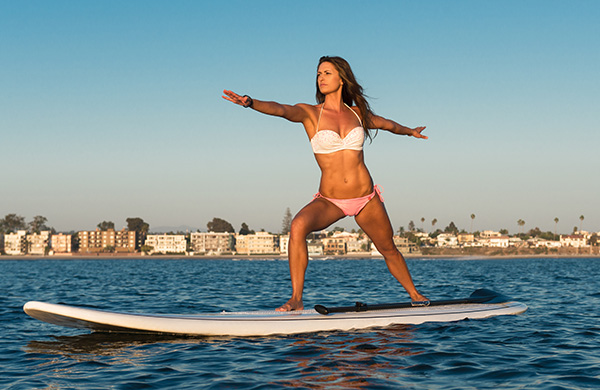
On paper, at least, nothing looks out of the ordinary about Hasna Atry’s yoga class. She starts her students off with sun salutations, then takes them through a series of lengthening stretches, breathing postures, and guided meditations. When that’s over, everyone paddles back to shore.
It’s that last part—the part about being out on the water—that tends to throw people. But that’s what separates SUP yoga from your typical studio-based yoga class. As one of the SUP yoga experts at Seattle’s WASUP Yoga, Atry specializes in finding the common ground between traditional yoga practice and stand-up paddleboarding.
So, just how different is a yoga class on the water? Atry likens it to “seeing a really awesome movie for the first time. It can be a thrill without being a high-risk activity.” Sara Laimon Luke of Wisconsin’s Koha Yoga tends to agree. “Once you try [yoga poses] on the board,” she claims, “your whole life is changed.” Curious to learn more, we asked these floating yogis for some tips on what to expect during a typical SUP yoga class.
Balancing is Easier Than You Think
“Some people think they have to be doing SUP yoga for a long time” in order to get the hang of it, Laimon Luke says, “but you can be a beginner.” People with stand-up paddleboard experience may be at a slight advantage, but it doesn’t take long for novices to find their sea legs. Atry notes that “curiosity” and “adventure” are common reasons for newbies to give SUP yoga a try, and she promises that people usually get over their nerves within a few minutes.
Age Isn't a Big Factor
While kids will want to check the minimum-age requirements (paddleboards don’t come with training wheels), most SUP yoga companies welcomes adults of all ages. “We’ve had a number of students come in and enjoy their 70th birthdays,” says Atry, which proves that you’re never too old to try something new.

You Probably Won’t Fall Off Your Paddleboard
Paddleboarding might seem like an activity that results in a lot of unintentional splash landings, but that simply isn’t the case, according to Atry. If that’s not enough to appease your fears, Laimon Luke notes that her SUP yoga students are even less likely to topple over than her regular paddleboarders. “Less people fall off during yoga because they’re so focused,” she explains.
Yoga Feels a Little Different On the Water
“It’s definitely training different areas of your muscles,” Laimon Luke explains. “Some of the most simple poses on the ground are some of the hardest you can do on the board.” Atry supports that assessment, admitting that some postures just aren’t feasible on a paddleboard. “I like to offer two points of balance,” she says, as having just one foot on the board can be really challenging.
Disciplines May Vary
SUP yoga isn’t restricted to one or two styles. Each of WASUP Yoga’s six instructors, for example, draws on a unique mix of disciplines (Atry tends to favor Hatha poses). Laimon Luke and Koha Yoga usually stick to Vinyasa, and some instructors may even incorporate the paddle into certain poses.

Clearing Your Mind Is a Piece of Cake
Concentrating on yoga poses, it turns out, becomes easier when you move out on the open water. Atry goes so far as to say that “it’s kind of cheating. You’re much further away from your troubles than you’d imagine … Your mind can’t be on the grocery list.”
The Setting Is More Scenic Than Your Local Studio
“It’s such an honor to provide people a vacation in their own backyard,” says Atry. WASUP Yoga classes float out on Puget Sound, and she notes that the setting—complete with harbor seals—often makes people forget that they’re standing on top of boards.
For the Best Session, Prepare Ahead of Time
It’s always a good idea to check with individual instructors for specific class requirements. Atry, for example, requires her students to know how to swim, while Laimon Luke allows non-swimmers to wear life jackets. She also recommends wearing layers and not eating two hours beforehand. Both instructors, of course, advocate having as much fun as humanly possible. After all, it’s not every day you get to practice yoga under an open sky.







